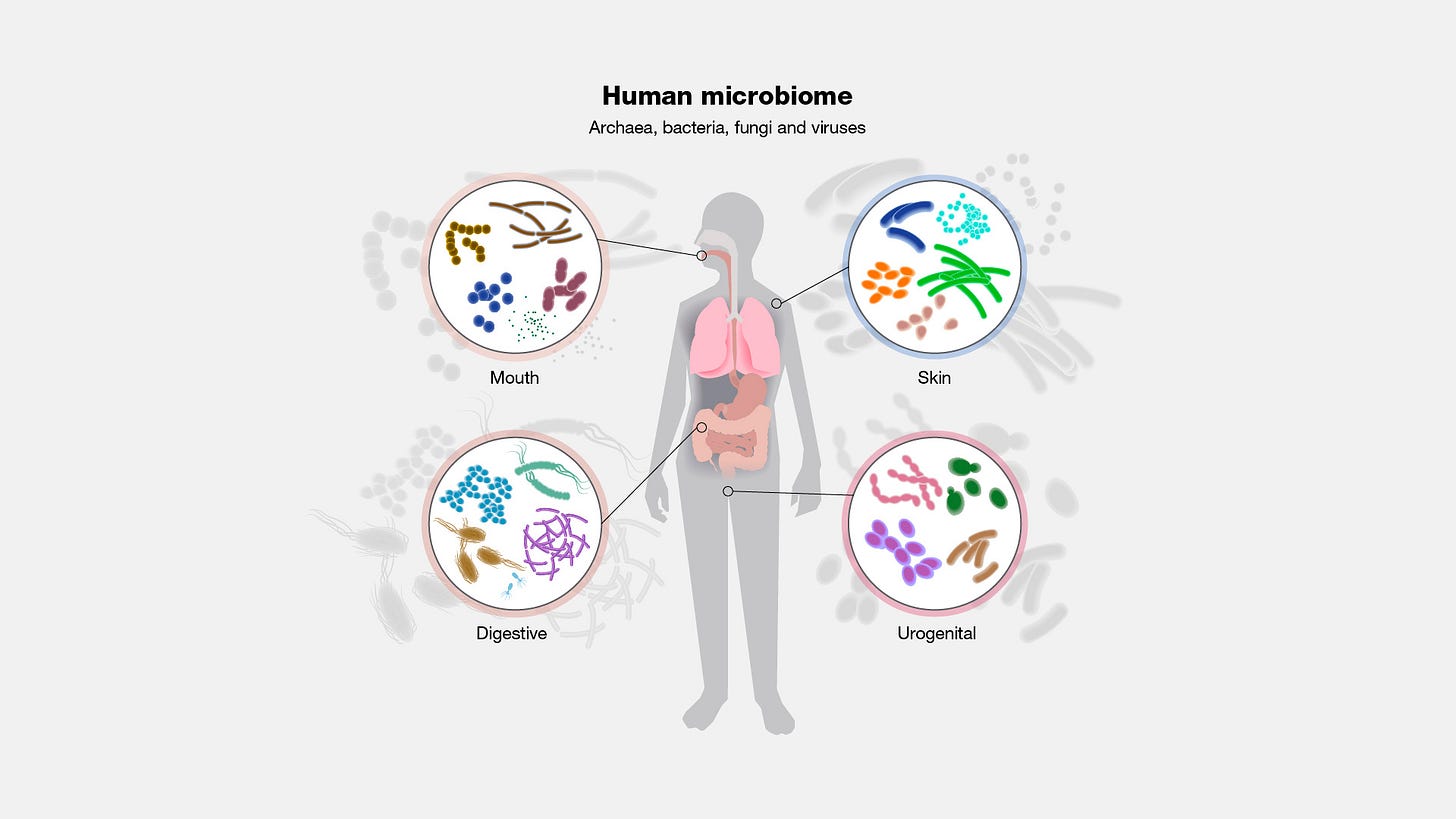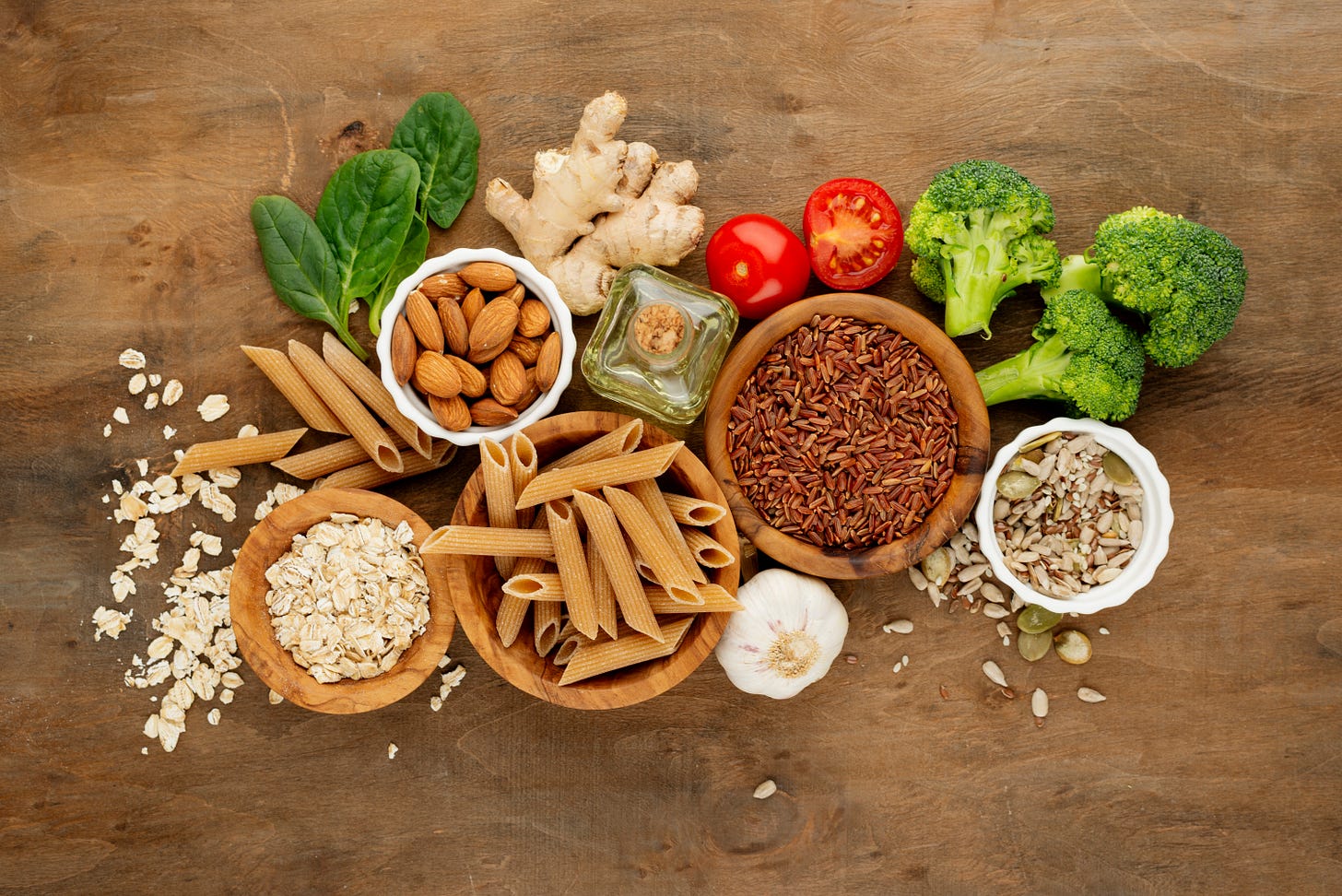What does a healthy, balanced diet look like?
Eating a healthy, balanced diet is one of the most important things you can do to protect your health.
Dear Incredible Machine Community,
Welcome back to another edition of The Incredible Machine newsletter. I am Dr. Paul Manhas, MD, Dad (x2), Husband, and co-owner of Manhas Health Co.
Embarking on a journey to optimal health often feels like navigating a maze of conflicting information and fad diets. But fear not, I’m here to illuminate your path to dietary enlightenment.
Understanding the Microbiome

If you didn’t read my previous article titled ‘How Does Your Gut Microbiome Impact Your Overall Health?’, and before we dive into the specifics of what foods to eat, let's take a moment to understand the role of the microbiome in a nutshell.
Your microbiome, composed of trillions of bacteria residing in your gut, plays a pivotal role in your overall health and well-being. By nourishing your microbiome with the right foods, you can support its balance and vitality, setting the stage for vibrant health.
Choosing the Right Foods
A Detailed guide when it comes to selecting foods for optimal health, there are a few key principles to keep in mind.
Here's a breakdown of what to look for:
High in Fiber: Aim for foods that are rich in fiber, such as fruits (e.g., apples, berries), vegetables (e.g., broccoli, spinach), legumes (e.g., chickpeas, lentils), and whole grains (e.g., oats, quinoa). Fiber not only supports digestive health but also nourishes your microbiome, promoting diversity and resilience within its microbial community.
High in Protein: Incorporate sources of high-quality protein into your diet, such as wild-caught salmon, free-range chicken, grass-fed beef, and pasture-raised eggs. These protein sources provide essential amino acids needed for muscle repair and overall health.
Low in Sugar and Preservatives: Minimize your intake of added sugars and preservatives, opting instead for whole, unprocessed foods. This includes avoiding sugary snacks and beverages, as well as processed foods loaded with artificial additives.
Low in Saturated Fat: Choose healthy sources of fat, such as nuts (e.g., almonds, walnuts), seeds (e.g., chia seeds, flaxseeds), avocados, and olive oil, while limiting your intake of saturated fats found in fried foods and fatty meats.
Key Foods to Include
Optimal Carbohydrates
This may be the most important group. Carbohydrates have a bad reputation, but remember they are the body's main fuel source. The problem is the choice of heavily processed carbohydrates which is driving up metabolic disease.
Focus on below-ground vegetables like sweet potatoes, carrots, and beets, as well as legumes (e.g., chickpeas, lentils) and whole grains (e.g., brown rice, quinoa).
These foods provide sustained energy and support gut health. Studies have shown that diets rich in whole grains and legumes are associated with lower risks of chronic diseases, including heart disease and type 2 diabetes.
Above-Ground Vegetables
Enjoy a variety of above-ground vegetables, such as leafy greens (e.g., kale, spinach), cruciferous vegetables (e.g., broccoli, cauliflower), and colorful peppers.
These vegetables are rich in vitamins, minerals, and antioxidants, which help protect against inflammation and oxidative stress. Research suggests that a diet high in vegetables is associated with a reduced risk of cancer and other chronic diseases.
Healthy Snacks
For convenient and nutritious snacks, reach for almonds, walnuts, pistachios, berries (e.g., blueberries, raspberries), plain popcorn, and dark chocolate. These options provide a satisfying crunch and a wealth of health benefits.
Studies have found that nuts and berries are associated with improved heart health and cognitive function, while dark chocolate is rich in antioxidants and may lower the risk of heart disease.
I eat 2-4 squares of 95% or 100% dark chocolate (Lindt brand) after dinner. If you're interested in trying this, start with 70% and work your way up!My Practical Recommendations for Everyday Eating :
1. Build Balanced Meals: Construct meals that include a combination of protein, fiber-rich carbohydrates, and healthy fats to support stable blood sugar levels, sustained energy, and satiety.
2. Plan: Plan your meals and snacks for the week, including a variety of nutrient-dense foods to meet your body's needs.
3. Stay Hydrated: Drink plenty of water throughout the day to support hydration, digestion, and overall health. Limit consumption of sugary beverages and opt for water, herbal tea, or infused water instead.
My general goal for most people is to drink enough to ensure you urinate every 2 hours or so. If you have gone more than 2 hours without urinating, it's a good sign that your body needs more water. Your urine color can also guide you. The darker your urine is, the more water your body desires.4. Practice Mindful Eating: Pay attention to hunger and fullness cues, and savor each bite by eating slowly and mindfully. Tune in to how different foods make you feel and adjust your choices accordingly.
Accompanying Video
Today’s newsletter is complemented by a video segment from my lecture on the Incredible Machine at SFU as I delve into this topic.
Closing Thoughts
As you embark on your journey to optimal health, remember that small changes can yield significant results.
By making mindful choices about the food you eat, you can nourish your body, support your microbiome, and unlock the key to vibrant health and vitality.
Here's to vibrant health and delicious meals—a journey worth savoring with every bite!
Dr. Paul Manhas, MD. CCFP
Co-founder & Director of Performance Services at Manhas Health Co. Clinical Instructor, UBC Faculty of Medicine.
Follow me on Instagram for more insights and Q&A: @drpaulmanhas






